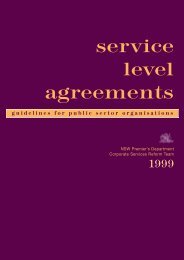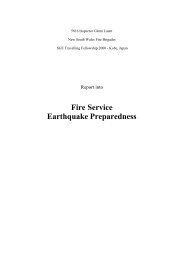Identify and respond to children and young people at risk - NSW ...
Identify and respond to children and young people at risk - NSW ...
Identify and respond to children and young people at risk - NSW ...
Create successful ePaper yourself
Turn your PDF publications into a flip-book with our unique Google optimized e-Paper software.
1.3 Training context<br />
1. Discuss PowerPoint 1.3: Training context noting: 2008<br />
Wood Inquiry <strong>and</strong> the Keep Them Safe initi<strong>at</strong>ives in <strong>NSW</strong> led <strong>to</strong><br />
changes regarding reporting <strong>and</strong> exchanging inform<strong>at</strong>ion <strong>and</strong><br />
other legisl<strong>at</strong>ive m<strong>at</strong>ters; emphasis on early intervention <strong>and</strong><br />
effective linking of families with services; raising threshold for<br />
st<strong>at</strong>u<strong>to</strong>ry intervention <strong>to</strong> <strong>risk</strong> of significant harm; highlighting<br />
the contributions th<strong>at</strong> all agencies can make <strong>to</strong> the safety,<br />
welfare <strong>and</strong> wellbeing of <strong>children</strong>.<br />
2. Acknowledge th<strong>at</strong> child protection is an emotive <strong>to</strong>pic th<strong>at</strong> can<br />
raise strong feelings <strong>and</strong> reactions. All of us were <strong>children</strong> who<br />
may have had a range of experiences, including those th<strong>at</strong><br />
caused us harm.<br />
Training may lead us <strong>to</strong> reassess experiences <strong>and</strong> identify harm<br />
<strong>and</strong> also celebr<strong>at</strong>e resilience th<strong>at</strong> we had not previously<br />
recognised, either in our own childhood experiences, or in our<br />
experiences as a parent, carer or practitioner. Participants may<br />
find after the training th<strong>at</strong> they need <strong>to</strong> use the str<strong>at</strong>egies they<br />
draw on <strong>to</strong> address stress <strong>at</strong> work. These str<strong>at</strong>egies may include<br />
discussion with their supervisor or colleagues, further reading or<br />
training, or taking time <strong>to</strong> reflect on issues raised.<br />
Refer <strong>to</strong> H<strong>and</strong>out 2: Addressing personal issues raised by<br />
this training which provides contact numbers for support<br />
services.<br />
3. <strong>Identify</strong> ways in which participants can promote a safe <strong>and</strong><br />
positive learning environment.<br />
Ensure th<strong>at</strong> the following points are covered:<br />
Confidentiality<br />
Ensuring everyone is heard <strong>and</strong> particip<strong>at</strong>es<br />
Acknowledging the right of participants <strong>to</strong> hold different points of view,<br />
Focus on learning not exploring personal experiences<br />
Respectful discussion (e.g. careful use of humour <strong>and</strong> avoiding racist or other<br />
discrimina<strong>to</strong>ry remarks or stereotyping)<br />
Self care<br />
Agreement re breaks <strong>and</strong> mobile phones.<br />
Keep Them Safe CHCCHILD401A – Facilita<strong>to</strong>r’s Manual<br />
© The <strong>NSW</strong> Technical <strong>and</strong> Further Educ<strong>at</strong>ion Commission<br />
(TAFE <strong>NSW</strong> – Industry Skills Unit, Meadowbank, 2010)<br />
12







